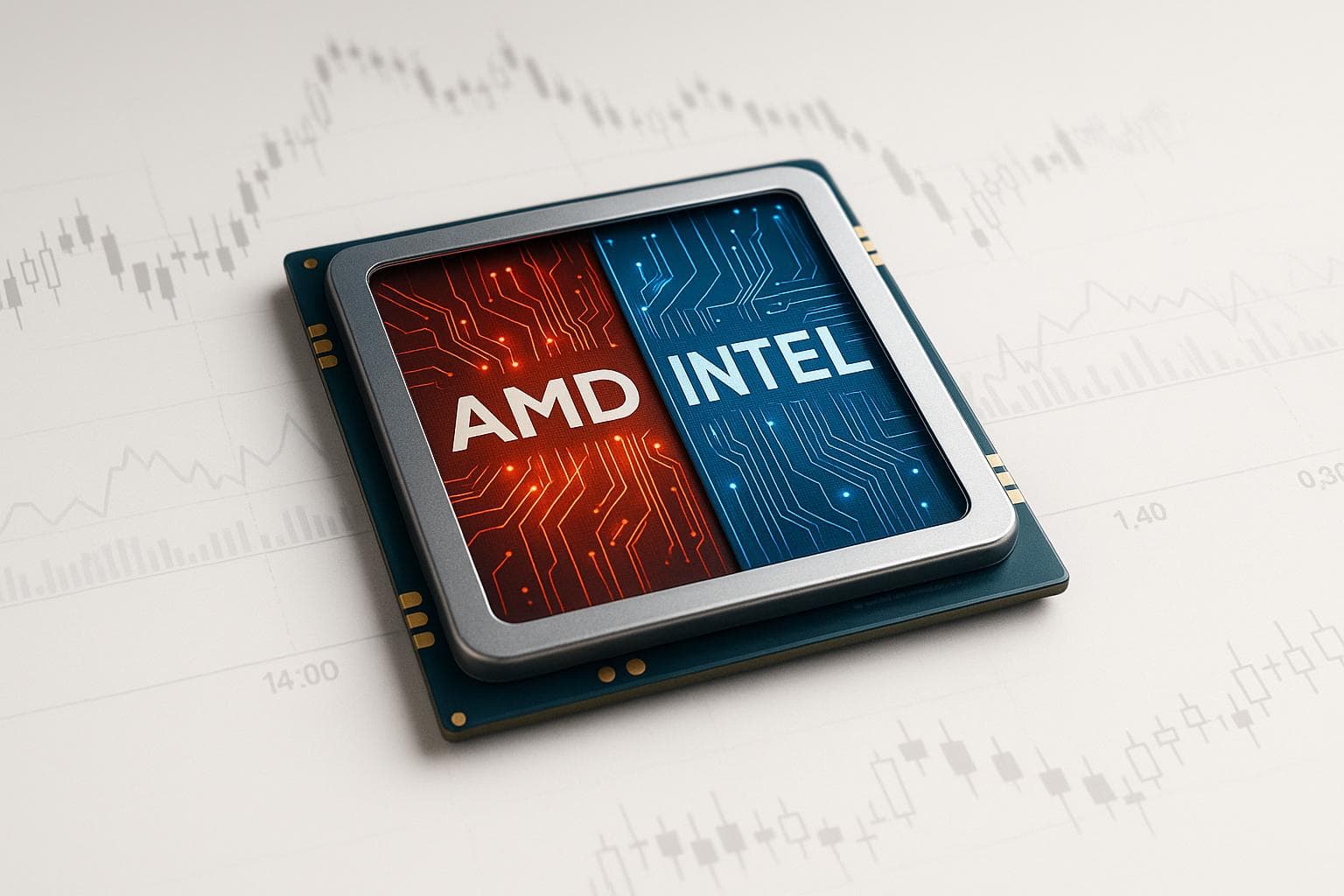Sierra Chart is a popular trading platform, but it’s not the only option. Depending on your trading style, hardware, and budget, other platforms might better suit your needs in 2025. Here’s a quick look at the top alternatives:
- TradingView: Web-based, real-time data, social trading features, free and paid plans.
- NinjaTrader: Desktop-based, strong for futures/forex, advanced automation tools, free charting with paid options.
- TradeStation: Integrated brokerage, excellent for stocks/options, commission-based pricing.
- Quantower: High customization, supports multiple assets, freemium model.
- Build Alpha: No-code strategy builder, backtesting tools, subscription-based plans.
- UltraAlgo: Focused on indicator-based strategies, visual strategy builder, subscription tiers.
- Ultimate Charting: Designed for forex, pattern recognition tools, starts at $59.
- Medved Trader: Desktop-focused, live quotes, freemium model.
- JigSaw Trading: Order flow analysis, real-time market depth, one-time purchase.
- cTrader: Multi-asset trading, ECN architecture, broker-dependent pricing.
Each platform offers unique features, from automation to advanced charting and data processing. Below is a quick comparison to help you decide.
MOTIVEWAVE VS SIERRA CHART VS TRADINGVIEW – WHICH IS THE BEST TRADING PLATFORM IN 2025?
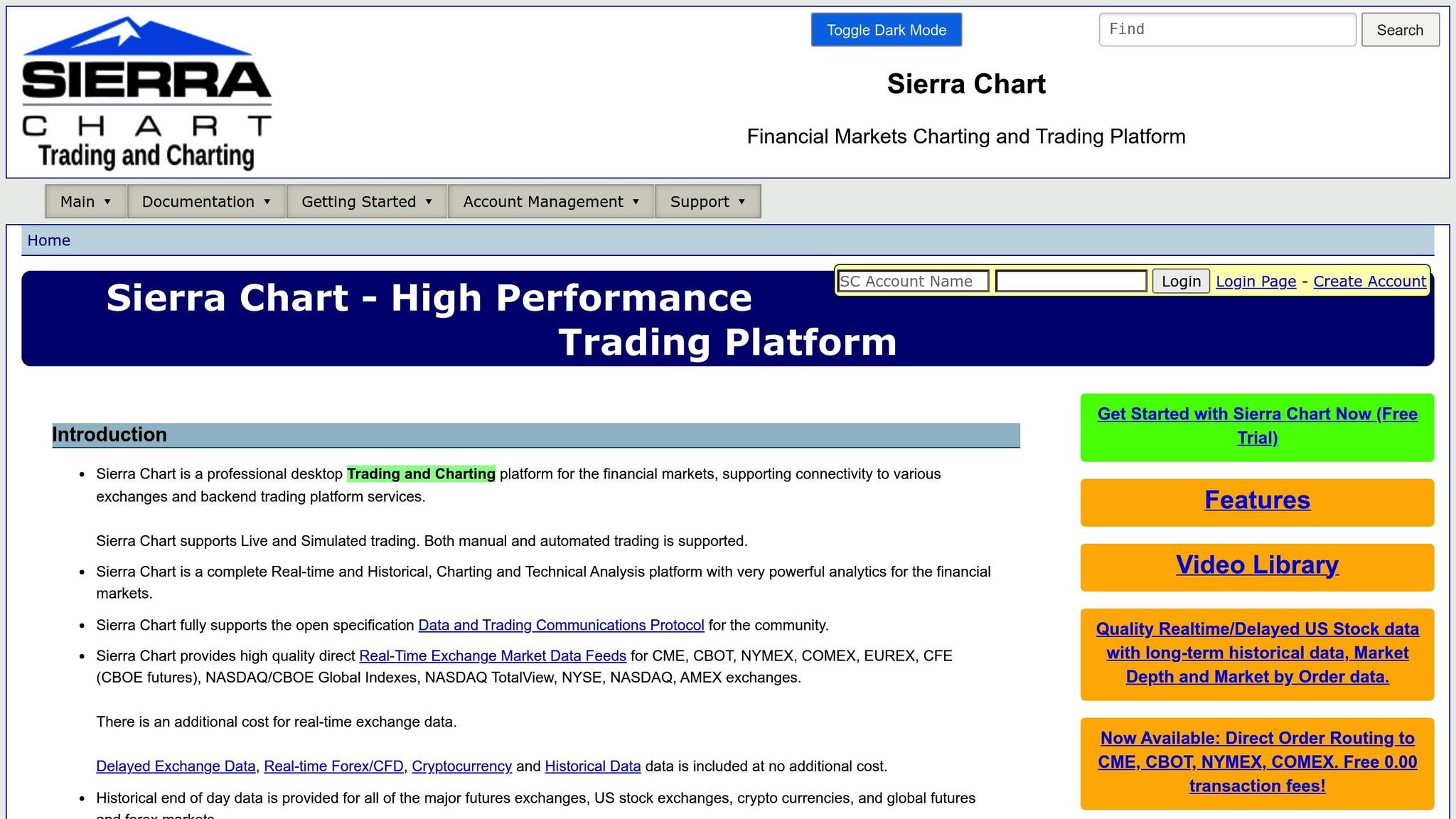
Quick Comparison
| Platform | Best For | Key Feature | Pricing Model |
|---|---|---|---|
| TradingView | Social trading | Browser-based, Pine Script | Freemium |
| NinjaTrader | Futures/forex trading | Advanced automation | Free/$99-$1,395 |
| TradeStation | Stocks/options trading | Integrated brokerage | Commission-based |
| Quantower | Multi-asset trading | Extensive customization | Freemium |
| Build Alpha | No-code automation | Drag-and-drop strategies | $29-$199/month |
| UltraAlgo | Indicator-based trading | Visual strategy builder | Subscription tiers |
| Ultimate Charting | Forex trading | Pattern recognition tools | $59+ |
| Medved Trader | Simple desktop trading | Live quotes, user-friendly | Freemium |
| JigSaw Trading | Order flow analysis | Market depth tools | $579-$1,799 (one-time) |
| cTrader | Multi-asset trading | ECN execution | Broker-dependent |
Explore these platforms to find the best fit for your trading goals and budget.
1. TradingView
TradingView is a versatile, web-based platform that works seamlessly on any modern browser, meaning you don’t need high-end hardware to get started. Thanks to its cloud-based infrastructure, the platform delivers consistent performance no matter where you’re located.
It’s a favorite among both retail and professional traders, largely because of its built-in social trading community. This feature allows users to share trading ideas, strategies, and market analyses in real time, creating a collaborative environment.
Real-Time Data Processing
TradingView offers real-time market data from a wide range of global exchanges, covering U.S. stock markets, forex, cryptocurrencies, and commodities. For U.S. equities, the platform provides Level 2 data and real-time quotes from major exchanges like the NYSE and NASDAQ. With its cloud infrastructure, updates are delivered with minimal delay, and the platform handles automatic updates and maintenance behind the scenes without disrupting your experience.
Charting & Analysis Tools
TradingView’s charting tools are as powerful as those found in traditional desktop software – yet everything runs directly in your browser. The platform comes loaded with technical indicators and tools, including moving averages, volume profiles, and support for multiple timeframes.
For traders who want to go beyond the basics, TradingView’s proprietary programming language, Pine Script, lets you create custom indicators and strategies. Plus, the community library gives you access to a massive collection of user-generated tools that you can use as-is or tweak to match your trading approach.
Automation & Algorithmic Trading
With Pine Script, you can develop automated trading strategies and backtest them using historical data. The backtesting feature provides detailed performance reports, helping you refine your algorithms before putting them to work.
TradingView also includes a paper trading feature, which creates a risk-free environment for testing strategies using live market data. When you’re ready to trade live, the platform integrates with brokers like Interactive Brokers and OANDA, allowing you to execute trades directly from the charts.
Pricing (USD)
TradingView follows a freemium model. The free plan comes with basic charting features, while paid subscription tiers unlock more advanced tools and capabilities. These include enhanced indicators, expanded alert options, and additional features tailored for active traders. While prices may vary, annual subscriptions generally offer better value compared to monthly plans.
With its blend of real-time data, advanced charting, and automation tools, TradingView stands out as a strong choice for traders at any level.
2. NinjaTrader
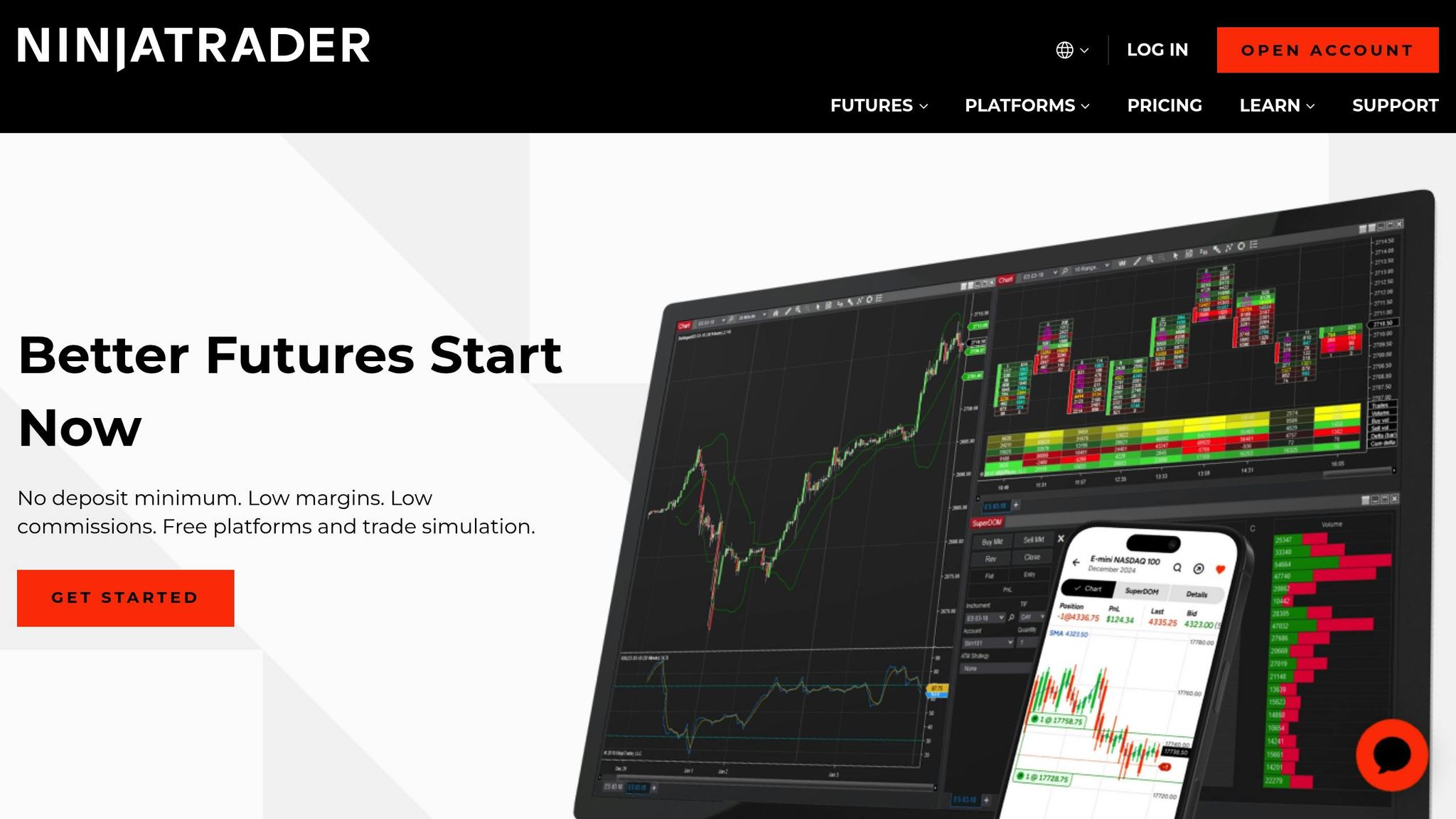
NinjaTrader is a Windows-based desktop trading platform that stands out for its speed. Unlike web-based platforms, this software taps directly into your computer’s processing power, making it a go-to choice for traders who prioritize performance and quick execution.
While it shines in the futures and forex markets, NinjaTrader also supports trading in stocks, options, and CFDs. The platform offers free charting and analysis tools, with the option to upgrade for advanced features and live trading capabilities. Its ability to optimize hardware resources aligns with the broader theme of tailoring trading tools to your system’s strengths. Let’s dive into how its real-time data processing enhances market responsiveness.
Real-Time Data Processing
NinjaTrader delivers real-time price, volume, and indicator data, empowering traders to make split-second decisions with precision. Its real-time feeds ensure you’re always up-to-date with the latest market activity.
The platform supports multiple data feeds from leading providers, offering broad market coverage. Some of the supported data providers include Kinetick (which also provides end-of-day data), eSignal, IQFeed, and Portara CQG. Here’s a quick look at the supported providers and brokers:
| Data Providers | Supported Brokers |
|---|---|
| Accelpix | Cedro Technologies |
| eSignal | FOREX.com / City Index |
| IQFeed | FXCM |
| Kinetick | Global Datafeeds |
| Lenz + Partner | Interactive Brokers |
| Portara CQG | TD Ameritrade |
| TrueData |
Accessing real-time data typically involves additional costs, which vary depending on the package and markets you trade. To manage expenses, consider starting with a basic package that aligns with your trading needs.
Charting & Analysis Tools
NinjaTrader offers highly customizable charts that allow you to tweak indicators, timeframes, and chart styles to suit your trading strategy. The real-time view helps traders identify critical patterns like trend reversals and pinpoint support and resistance levels as they develop.
The platform’s charting engine handles multiple timeframes seamlessly, ensuring smooth performance even when analyzing several instruments at once. You can overlay technical indicators, draw trend lines, and study price action without slowing down your system. To keep your setup running efficiently, limit the number of active indicators and timeframes, and take advantage of NinjaTrader’s optimization tools, such as clearing the cache and historical data regularly.
Automation & Algorithmic Trading
For those diving into algorithmic trading, NinjaTrader provides robust tools. It uses historical data for backtesting strategies before moving to live trading. With real-time tick-by-tick data, the platform allows for precise execution of automated strategies using features like SetTrailStop() and SetParabolicStop(). This granular level of control ensures that your strategies respond to every market movement, rather than waiting for a bar to close.
NinjaTrader also supports custom development through its NinjaScript programming language, enabling traders to create personalized indicators, strategies, and fully automated trading systems.
Pricing (USD)
NinjaTrader offers a flexible pricing structure, making it accessible to both beginners and seasoned traders. The platform is free for charting, backtesting, and market replay, which is ideal for strategy development without any initial costs. When you’re ready to trade live, you can:
- Lease the software for $99 per month
- Purchase a lifetime license for $1,395
For those looking to integrate third-party brokers, a Multi-Broker add-on is available for $99 per month. Keep in mind that data fees are separate and depend on your chosen provider and the level of market access required.
3. TradeStation
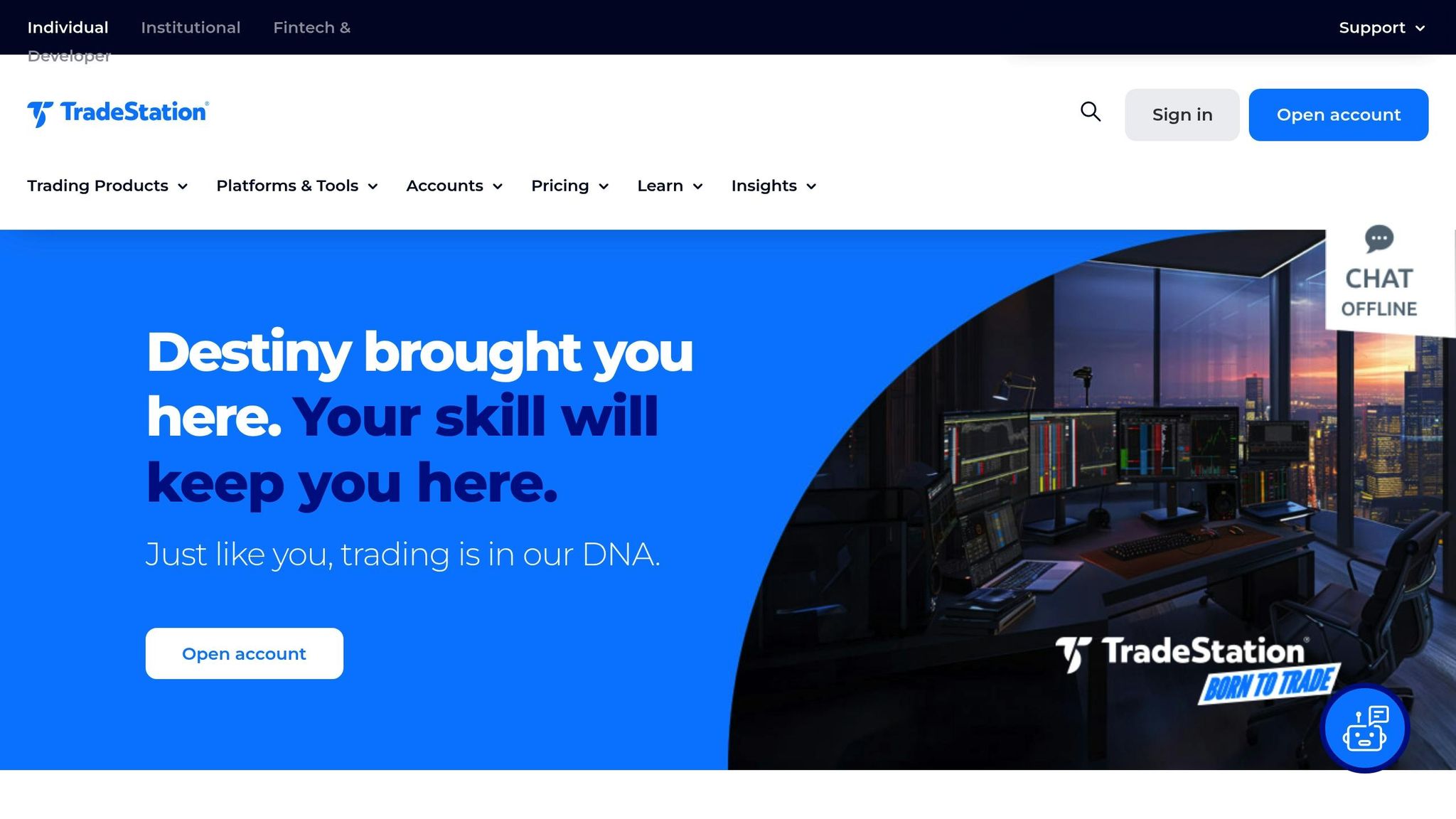
TradeStation is a robust platform that combines advanced analysis tools with direct market access. It supports a variety of asset classes, including stocks, options, futures, and cryptocurrencies. By integrating trading and brokerage services, it eliminates the hassle of connecting separate software to different brokers. Here’s a closer look at what TradeStation brings to the table.
Real-Time Data Processing
TradeStation’s proprietary network ensures fast and efficient processing of real-time market data, making it ideal for split-second decision-making. The platform also provides in-depth market data for multiple asset classes, including advanced market depth views. For those trading globally, it offers access to market data from international exchanges.
Charting & Analysis Tools
The platform stands out with its advanced charting capabilities. Using its RadarScreen tool, you can scan securities in real time and set up alerts for technical patterns, price movements, or volume changes. It also includes a wide range of built-in technical indicators, drawing tools, and customizable chart layouts to suit your trading style.
Automation & Algorithmic Trading
TradeStation simplifies algorithmic trading with its EasyLanguage programming environment, which doesn’t require deep coding knowledge. Its Strategy Testing feature allows you to backtest automated strategies using historical data and review detailed performance metrics. For live trading, the platform’s automated execution system manages orders, position sizes, and risk controls based on your predefined rules. It even supports managing multiple strategies across various accounts and asset classes simultaneously.
Pricing (USD)
TradeStation uses a commission-based pricing model. Stock and ETF trades can be commission-free under certain conditions, while options and futures trades come with commissions that vary depending on trade volume and account activity. There are no additional fees for accessing the platform if you maintain an active trading account, but premium features and advanced tools may incur extra monthly charges. If you need international market data, additional fees might apply based on the exchange and level of data access you require.
4. Quantower
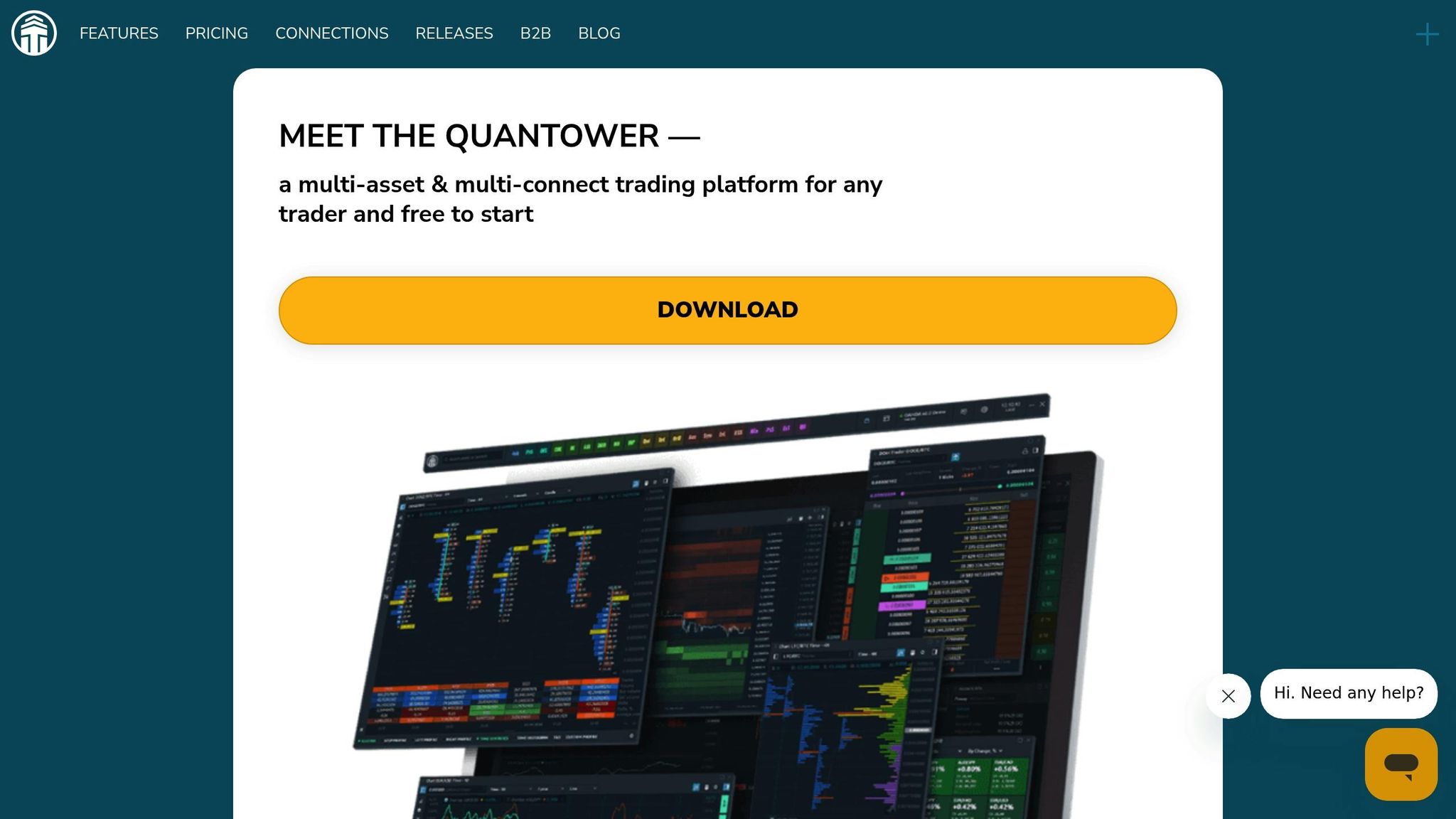
Quantower is a trading platform designed to cater to professionals by offering a highly customizable interface and support for multiple asset classes. It equips traders with the tools they need to analyze markets effectively and manage orders with ease.
Real-Time Data Processing
Quantower connects directly to various exchanges and data providers, ensuring traders receive real-time market data. This setup allows for quick processing of market updates, giving users access to the critical information they need to make timely decisions.
Charting and Analysis Tools
With its focus on volume analysis and customizable visualizations, Quantower provides advanced charting tools. Traders can leverage technical indicators and tailor charts to identify key market levels and emerging trends, helping them stay ahead in dynamic trading environments.
Automation and Algorithmic Trading
For those seeking to automate their trading, Quantower offers a range of tools to streamline order management and execution. Developers can also create custom indicators and strategies, thanks to the platform’s support for programming. Plus, its backtesting features let users evaluate trading ideas before applying them in real markets.
Pricing (USD)
Quantower operates on a freemium model. The free version includes basic features, while premium subscriptions unlock advanced tools and additional data feeds. Pricing depends on the subscription level and the specific market data services required, offering flexibility for different trading needs.
5. Build Alpha
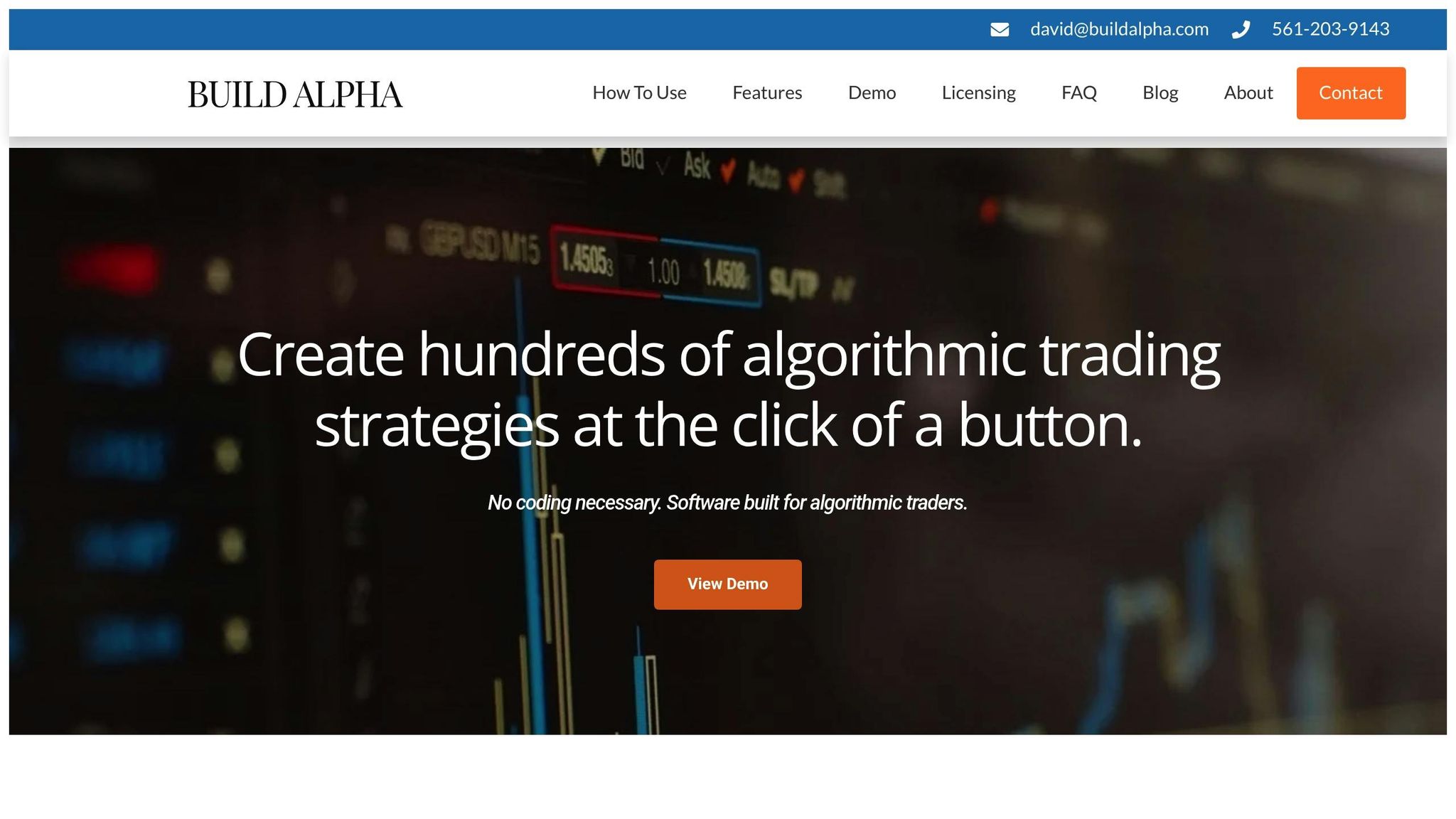
Build Alpha is a cloud-based trading platform designed to make algorithmic trading accessible for traders at all levels. By focusing on simplicity and practicality, it offers tools for developing and testing trading strategies without requiring users to have programming expertise. Let’s dive into how Build Alpha’s charting tools, automation features, and pricing structure make it a go-to choice for traders looking to automate their strategies.
Charting & Analysis Tools
Build Alpha equips users with intuitive charting tools that integrate seamlessly with its visual strategy builder. Instead of relying on complex coding, the platform uses drag-and-drop functionality, allowing traders to design strategies and analyze markets effortlessly.
With support for multiple timeframes and chart types, users have the flexibility to tailor their analysis. The platform also enables the overlay of custom indicators and the combination of various technical analysis tools. This makes it easier to spot trading opportunities across different market conditions, whether you’re analyzing trends or seeking precision in volatile markets.
Automation & Algorithmic Trading
At the heart of Build Alpha is its no-code algorithm creation environment, which empowers traders to design and deploy automated strategies without needing programming skills. Using a visual interface, traders can define logical trading rules that are instantly converted into executable algorithms.
The platform’s backtesting engine is a standout feature, letting users test their strategies against historical data. It provides detailed performance metrics like profit and loss, drawdown, and win rates, giving traders a clear understanding of their strategy’s potential. For added confidence, the platform includes paper trading, so users can test their algorithms in live market conditions without risking any money.
When it’s time to go live, Build Alpha offers built-in risk management tools. Features like position sizing, stop-loss settings, and other risk parameters help traders protect their capital while executing strategies in real-time.
Pricing (USD)
Build Alpha offers flexible subscription plans to cater to different trading needs. The basic plan, starting at approximately $29 per month, includes access to the strategy builder and backtesting tools, though with limited historical data. For more advanced features like expanded data access, enhanced backtesting options, and live trading capabilities, higher-tier plans are available, ranging from $79 to $199 per month.
To help traders get started, Build Alpha frequently offers free trial periods. Additionally, all plans include educational resources and access to a supportive community, ensuring users can make the most of the platform’s features.
sbb-itb-24dd98f
6. UltraAlgo
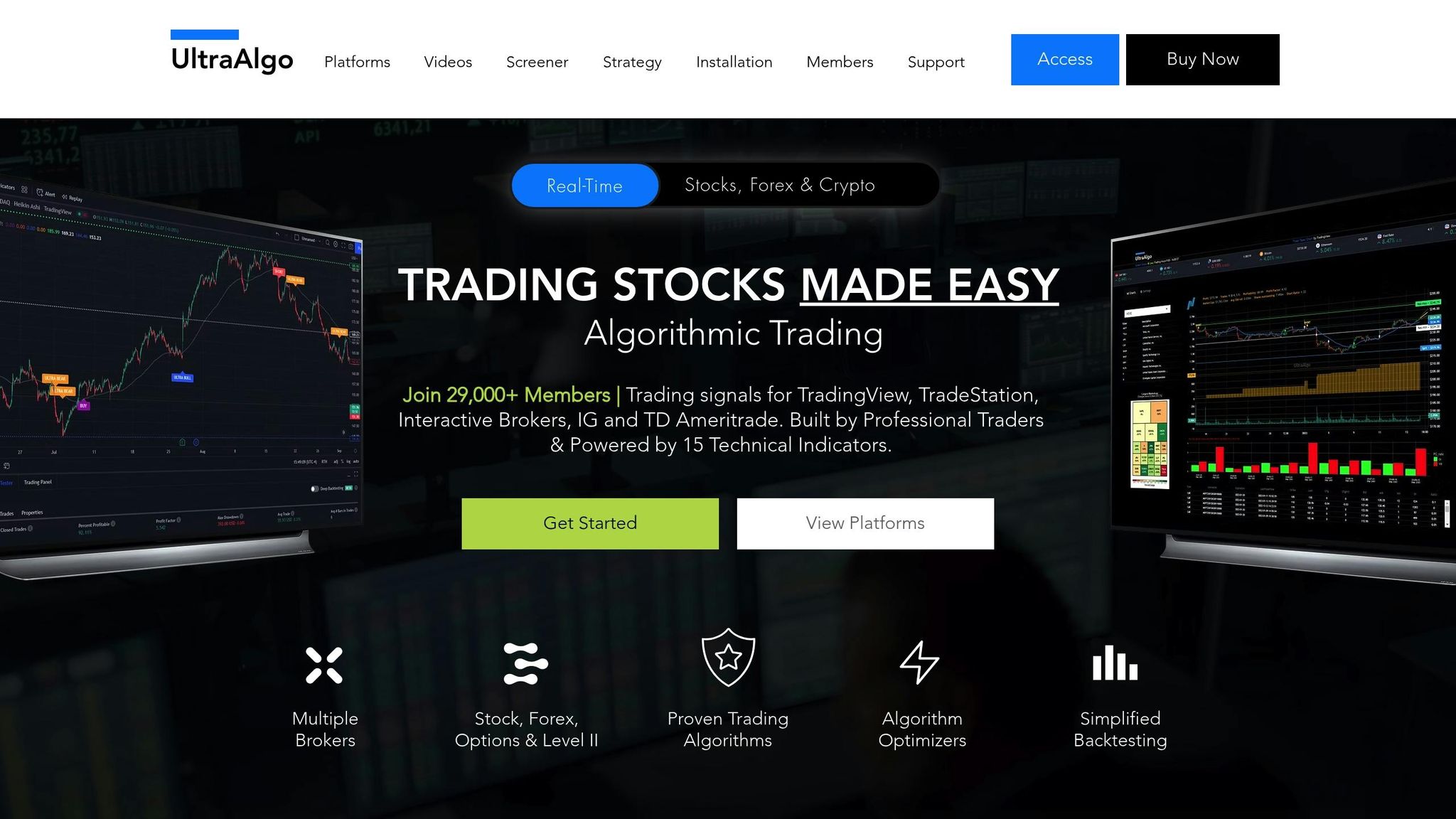
UltraAlgo is an algorithmic trading platform designed to help traders automate their strategies without the need for coding. It provides tools that cater to both beginners and experienced users, offering a streamlined way to implement and manage trading strategies.
Real-Time Data Processing
UltraAlgo ensures fast and accurate processing of market data. By connecting to multiple data feeds at once, it delivers broad coverage across various asset classes, including stocks, forex, futures, and cryptocurrencies. Built-in data validation protocols work to identify and correct anomalies, reducing the risk of false signals. This efficient data handling forms the backbone of the platform’s analytical and automation capabilities, making it a versatile tool for traders.
Charting & Analysis Tools
The platform includes advanced charting tools packed with technical indicators and drawing features. UltraAlgo’s charts allow traders to view multiple timeframes in a single window, making it easy to analyze everything from short-term tick data to long-term trends. The system supports multi-asset analysis, enabling traders to overlay different instruments for correlation studies or pair trading. Additional tools like heat maps, market scanners, and pattern recognition features further enhance the ability to spot trading opportunities.
Automation & Algorithmic Trading
UltraAlgo simplifies strategy automation with its visual strategy builder. This tool uses intuitive flowcharts to create complex algorithms, and the platform also provides pre-built templates for popular strategies like momentum trading, mean reversion, and arbitrage. These templates can be customized to fit individual goals and risk preferences. Integrated risk management features, such as position sizing and drawdown limits, help control exposure, while portfolio-level monitoring provides a broader view of performance. The backtesting engine uses extensive historical data to deliver metrics like the Sharpe ratio and maximum drawdown, and walk-forward optimization ensures strategies are refined for varying market conditions.
Pricing
UltraAlgo offers several subscription options to suit different trading needs. The entry-level plan includes basic charting tools, limited backtesting capabilities, and support for a small number of automated strategies. A more advanced plan unlocks additional features, such as unlimited strategy creation, enhanced backtesting with extensive historical data, a full suite of technical indicators, and priority customer support. For professional and institutional traders, the Enterprise plan provides multi-account management, API access for custom integrations, dedicated support, and assistance with custom strategy development. This plan also offers early access to new features. All subscription tiers include a free trial, along with access to educational resources and webinars.
7. Ultimate Charting
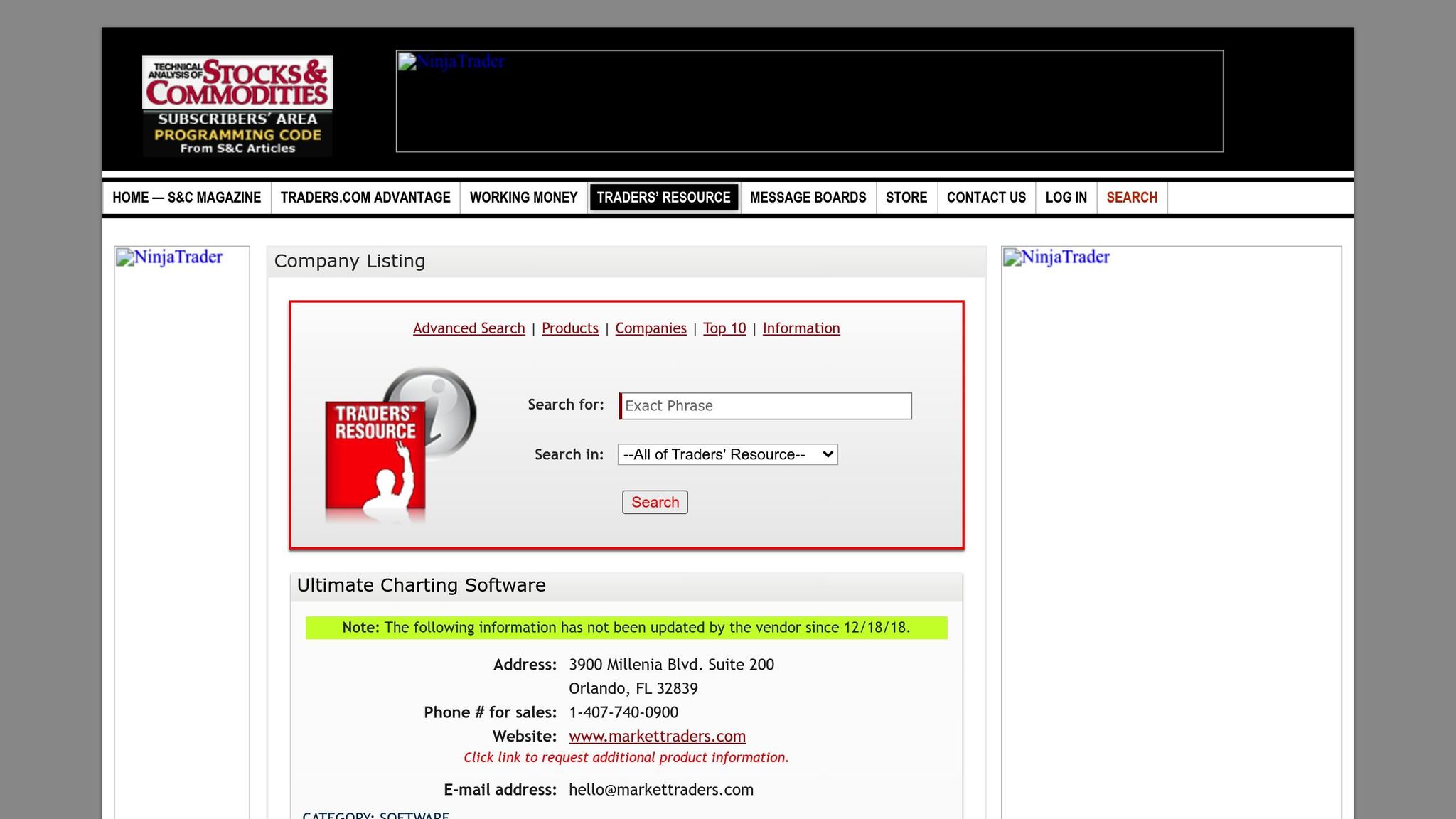
Ultimate Charting Software, developed by Market Traders Institute, is designed to provide forex traders with powerful tools for charting and pattern recognition. Here’s a closer look at what it offers:
Real-Time Data Processing
This platform supports real-time data processing, offering live market updates to help traders make timely and informed decisions.
Charting & Analysis Tools
Ultimate Charting comes packed with over 200 preloaded indicators, giving traders a comprehensive toolkit for market analysis. One standout feature is the Auto-Fib tool, which simplifies Fibonacci analysis. By selecting an A–B boundary, the software automatically calculates Fibonacci extensions and retracements, saving time and effort.
The software also includes a drag-and-drop patterns tool, allowing traders to easily identify formations like Kings Crown, head and shoulders, and double bottoms. Recognized patterns are highlighted on the charts, making it easier to spot potential entry and exit points. Another notable feature is its ability to automatically detect major market reversal patterns – helping traders act before opportunities slip away.
Pricing
Ultimate Charting is available starting at $59. However, with limited user reviews on platforms like SourceForge, there’s not much feedback available regarding its long-term reliability.
8. Medved Trader
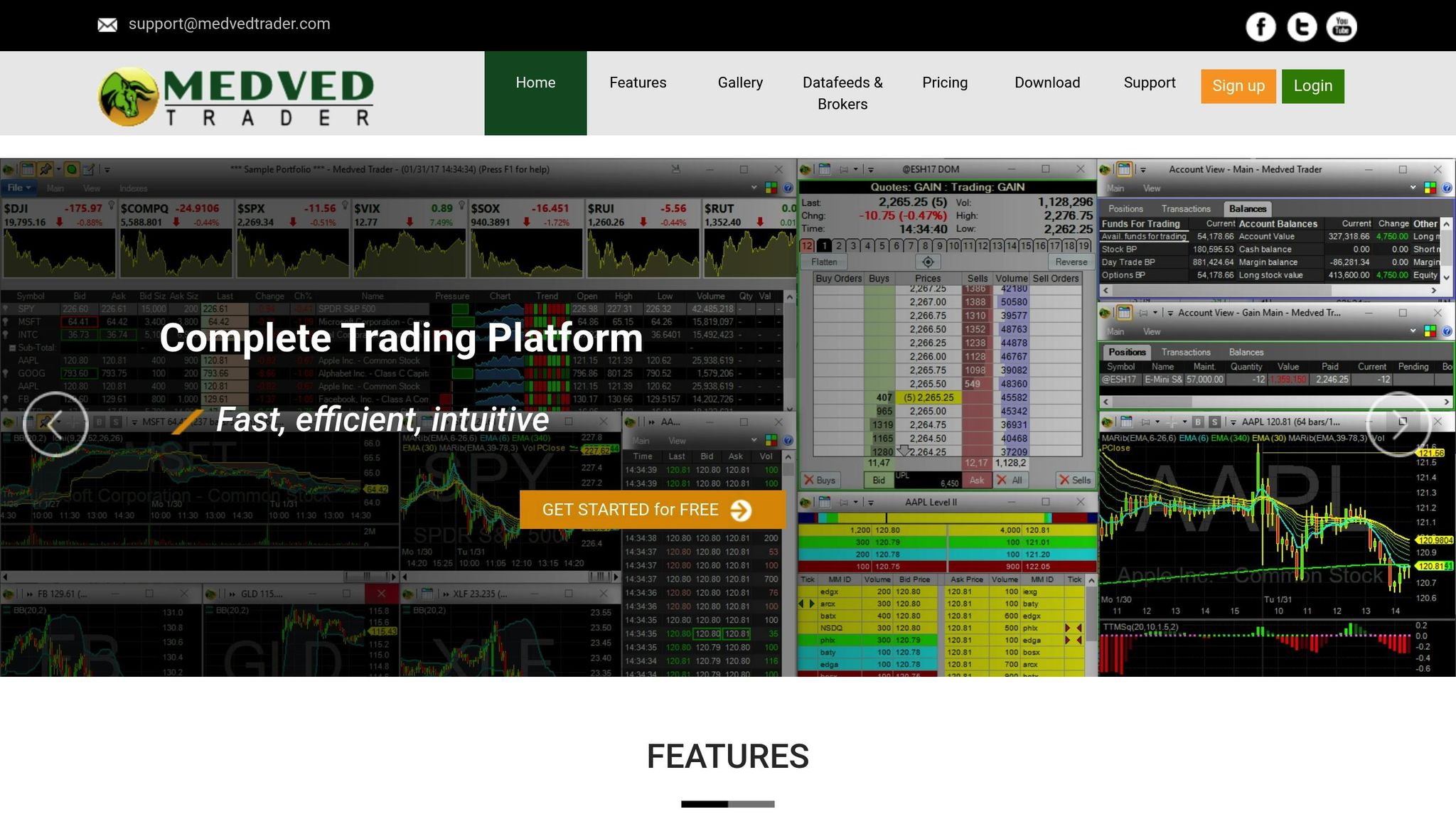
Medved Trader stands out with its desktop-centric trading platform tailored for active traders. Designed to deliver powerful data processing and advanced charting tools, it helps users keep a close eye on market activity and analyze trends effectively. The platform is optimized for desktop setups, offering robust performance and customizable layouts to suit individual trading styles.
Real-Time Data Processing
One of Medved Trader’s key strengths is its ability to display live quotes and charts while managing multiple data feeds simultaneously. It ensures uninterrupted access by automatically reconnecting disrupted feeds and supports multiple levels of market data, giving traders a deeper understanding of market conditions.
Charting and Analysis Features
The platform is packed with tools to enhance market analysis. It includes built-in technical indicators, drawing tools, and multi-timeframe charting. Users can also customize layouts, set alerts for significant market changes, and track their portfolios – all within a single platform.
Pricing
Medved Trader offers a flexible freemium pricing model. The basic version is free, while advanced features are accessible through either a premium subscription or a lifetime license. This structure makes it accessible to traders with varying budgets and needs.
9. JigSaw Trading
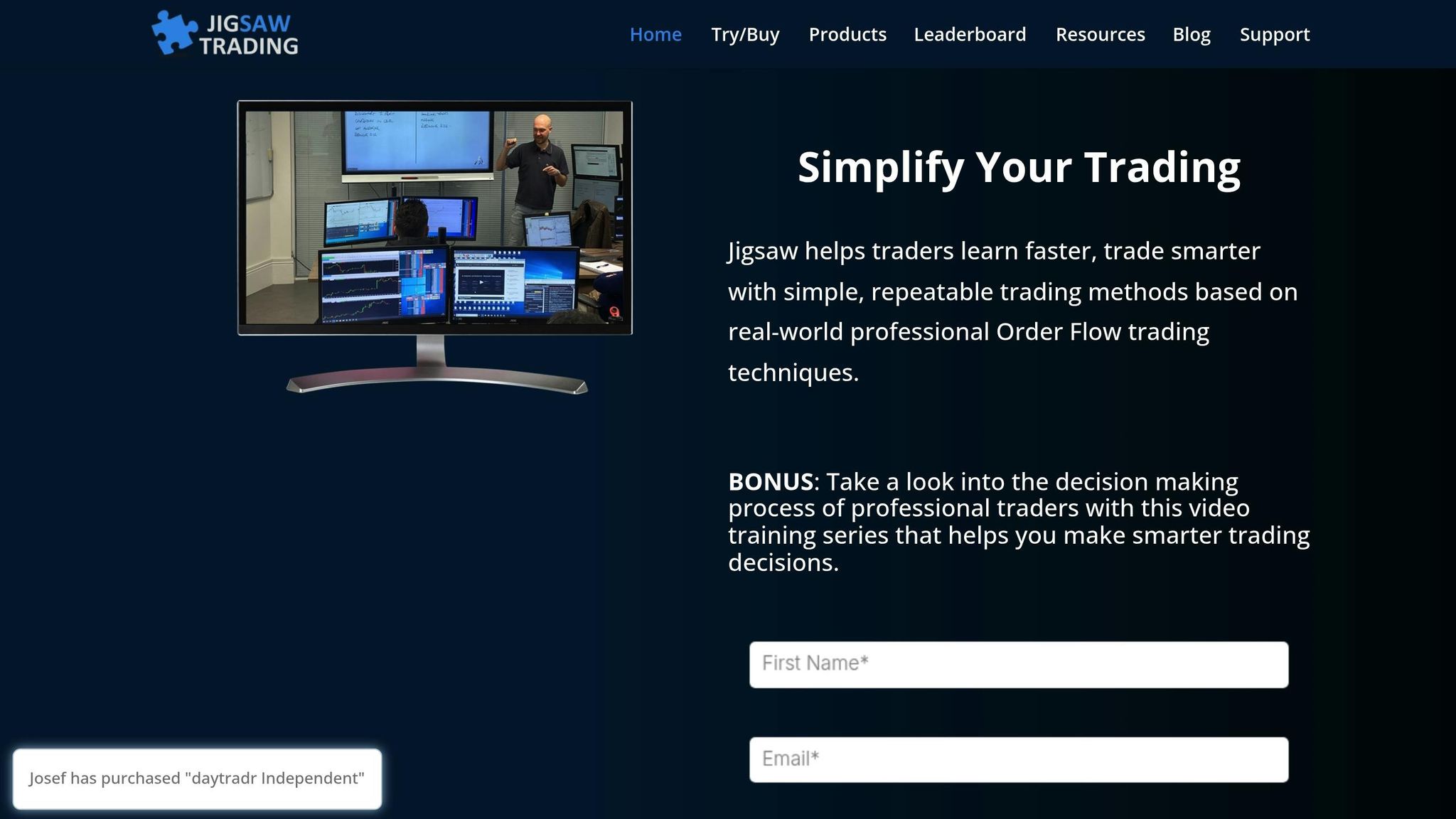
JigSaw Trading stands out as a platform designed specifically for traders who rely on order flow analysis and market depth visualization. Tailored for day traders and scalpers, this desktop-based solution provides tools that reveal the underlying forces driving price movements, offering a deeper understanding of market dynamics.
The platform excels at helping users interpret market sentiment by showcasing how orders move through the market in real-time. Its visual tools highlight institutional activity, pinpoint key support and resistance levels, and uncover potential price reversals – all critical insights for active traders.
Real-Time Data Processing
JigSaw Trading processes Level II market data to provide a detailed look at real-time order book activity through its Depth and Sales (DOM) tool. This feature breaks down tick-by-tick market activity, allowing traders to monitor every transaction as it happens and understand the mechanics behind price changes.
For added depth, the platform includes a Reconstructed Tape feature, which replays past market events. This allows traders to review significant price movements and refine their ability to read order flow. Together, these tools ensure traders have a complete picture of market activity as it unfolds.
Charting and Analysis Tools
JigSaw Trading’s Auction Vista tool transforms standard charts into heat maps, clearly highlighting zones with the highest trading activity. For those looking to analyze their performance, higher-tier packages include Journalytix, a trade journaling and analytics tool. Journalytix automatically tracks trading data, helping traders identify patterns in both successful and unsuccessful trades. The generated reports provide actionable insights, making it easier to fine-tune strategies over time.
Pricing (USD)
JigSaw Trading offers a one-time purchase model with four pricing tiers, catering to both retail and institutional traders:
| Package | Price | Key Features |
|---|---|---|
| Independent | $579 | Includes DOM tool, Auction Vista, and Reconstructed Tape |
| Professional | $879 | All Independent features plus advanced trade analytics |
| Market Maker | $1,499 | Adds advanced market-making tools |
| Institutional | $1,799 | Offers full customization and professional support for trading firms |
For direct trade execution, traders need to purchase an additional monthly or annual subscription. This pricing structure is well-suited for serious retail traders while also providing institutional-grade tools for professionals. With its robust features and focus on order flow analysis, JigSaw Trading is a compelling option for those looking to gain an edge in fast-paced markets.
10. cTrader
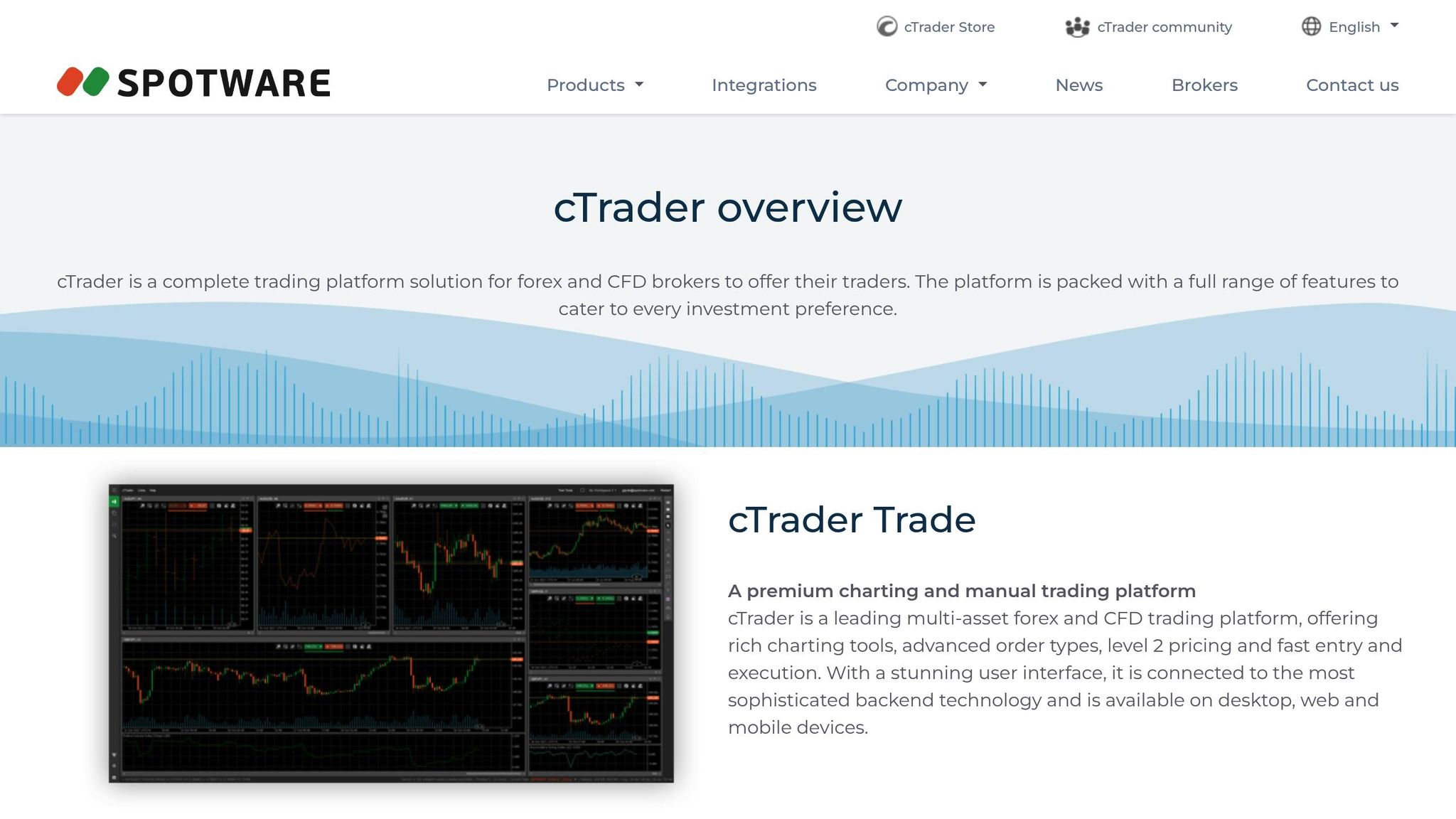
cTrader delivers a robust trading platform that combines advanced charting tools with reliable execution technology. Over the years, it has become a go-to solution for both individual traders and professional money managers.
This platform stands out for its multi-asset trading features and smooth integration across desktop, web, and mobile devices. Whether you’re trading forex, CFDs, indices, commodities, or cryptocurrencies, cTrader offers a unified interface that ensures a consistent experience across all devices. It also includes a suite of advanced tools that cater to traders at all levels.
Real-Time Data Processing
cTrader excels in handling market data efficiently. It uses a Level II pricing engine that aggregates liquidity from various sources, helping to deliver competitive spreads and fast execution. Its ECN (Electronic Communication Network) architecture ensures traders receive real-time bid and ask prices directly from liquidity providers. On top of that, tick-level processing provides detailed market depth, allowing traders to assess available volume with precision.
Charting & Analysis Tools
cTrader’s charting features are packed with built-in technical indicators and drawing tools, offering flexibility for traders to customize their analysis. Timeframes can be adjusted to suit specific needs, from short-term tick charts to long-term views. Additionally, the platform includes a sentiment analysis tool that displays the balance between long and short positions, giving traders insights into the overall market sentiment.
Automation & Algorithmic Trading
For traders interested in automation, cTrader provides a powerful solution. Its cAlgo environment supports C#-based algorithmic trading, complete with a backtesting engine to test strategies using historical data. The platform also features a cBots marketplace, where users can access and share community-developed strategies. Traders can even design and share custom indicators, making it easier to create personalized trading strategies.
Pricing (USD)
cTrader’s pricing depends on the broker you choose. The platform itself is free to download and use, but trade execution costs are determined by the broker’s pricing model. For institutional clients, cTrader offers white-label solutions with custom pricing tailored to trading volume and specific business needs.
Platform Comparison: Pros and Cons
Choosing the right trading platform depends on your trading style, experience, and technical requirements. Each platform has its own set of strengths and weaknesses, so it’s essential to weigh them carefully. Here’s a breakdown of the top platforms, their standout features, and potential drawbacks.
TradingView is ideal for social trading enthusiasts. Its web-based interface allows for community-driven insights and seamless access across devices. However, it requires integration with an external broker to execute trades.
NinjaTrader shines with its advanced charting, strategy development, and backtesting tools, making it a favorite among algorithmic traders. That said, its steep learning curve can be intimidating for beginners.
TradeStation caters to active equity and options traders, offering a comprehensive suite of tools and strong research capabilities. However, its fee structure might not be cost-effective for traders with lower volumes.
Quantower provides professional-grade features, including extensive customization and support for multiple assets. While powerful, its complex interface can be daunting for newcomers.
Build Alpha simplifies algorithmic trading with its no-code strategy builder, making automation accessible. However, as a newer platform, it still lacks extensive community resources and integrations.
UltraAlgo focuses on indicator-based trading with backtesting capabilities, making it a solid choice for technical analysis. But it may fall short for traders who rely on fundamental analysis.
Ultimate Charting is tailored for traditional chart analysis, offering tools specifically designed for standard techniques. However, it lacks the advanced capabilities that algorithmic traders often seek.
Medved Trader prioritizes simplicity and reliable performance with integrated data feeds. While user-friendly, it doesn’t offer the extensive features found in more advanced platforms.
JigSaw Trading specializes in order flow and market depth analysis, making it a go-to for traders who depend on detailed market data. However, its niche focus might not align with strategies centered on technical indicators.
cTrader supports multi-asset trading with strong mobile integration and ECN architecture, appealing to algorithmic traders. On the downside, it offers fewer broker options compared to other platforms.
| Platform | Best For | Key Strength | Main Limitation |
|---|---|---|---|
| TradingView | Social trading and analysis | Community-driven insights and accessibility | Requires external broker connection |
| NinjaTrader | Futures/forex algorithmic trading | Advanced charting and backtesting tools | Challenging for beginners |
| TradeStation | Active equity/options trading | Comprehensive tools and research | Fee structure may deter low-volume traders |
| Quantower | Professional multi-asset trading | High customization and advanced order flow tools | Complex interface for new users |
| Build Alpha | No-code algorithmic trading | Simplified automation without coding | Limited community and integrations |
| UltraAlgo | Indicator-based technical trading | Backtesting and technical focus | Lacks fundamental analysis features |
| Ultimate Charting | Traditional chart analysis | Tools tailored for standard techniques | Missing advanced algorithmic features |
| Medved Trader | Reliable data integration | Straightforward interface and data feeds | Limited advanced features |
| JigSaw Trading | Market data analysis | Order flow and market depth insights | Specialized focus may not suit all strategies |
| cTrader | Multi-asset forex/CFD trading | Mobile integration and ECN architecture | Limited broker options |
For short-term traders, platforms with strong order flow and market depth analysis, like JigSaw Trading, are often the best fit. Meanwhile, those focused on long-term strategies may benefit more from platforms with in-depth charting and research tools, such as TradeStation.
Algorithmic traders should prioritize platforms that offer advanced strategy development and automation, like NinjaTrader or Build Alpha. Be sure to factor in costs, including subscription fees, data feed charges, and brokerage expenses, when making your decision. Hardware compatibility is another consideration – web-based platforms offer flexibility, while desktop applications may require specific operating systems and robust hardware to handle complex strategies effectively.
Final Thoughts
Choosing the best Sierra Chart alternative boils down to matching your trading needs with the features each platform offers. For traders who appreciate community insights and need access across various devices, TradingView is a solid pick. On the other hand, NinjaTrader caters to algorithmic traders with its advanced backtesting and strategy development tools.
If you’re an active equity or options trader, TradeStation provides robust research and analysis tools, though it comes with higher costs. Multi-asset traders might lean towards Quantower, especially for its professional-level order flow capabilities – just be ready for a steeper learning curve.
For automation, Build Alpha and UltraAlgo serve different purposes. Build Alpha focuses on creating automated strategies without requiring coding, while UltraAlgo is tailored for technical, indicator-based trading. Traditional chart analysts may prefer the simplicity of Ultimate Charting, and those prioritizing data integration over advanced features will find Medved Trader reliable.
If your trading relies on specialized tools, JigSaw Trading excels in market depth analysis, while cTrader offers an ECN setup ideal for forex and CFD traders. It’s also worth noting that hardware requirements can vary significantly between platforms, so factor that into your decision.
Budget plays a key role too. Consider subscription fees, data costs, and brokerage charges when evaluating options. Many platforms provide free trials, so take advantage of these to test how well they align with your strategies before making a commitment. Remember, the most expensive platform isn’t always the best fit. Sometimes, a simpler and more affordable solution can be more effective if it aligns with your trading style and experience.
Ultimately, the key is to match the platform’s capabilities with your trading frequency, style, and overall strategy. Take the time to weigh each platform’s strengths and costs to find the one that best supports your trading goals.
FAQs
What are the main differences between desktop-based and web-based trading platforms discussed in the article?
Desktop-based trading platforms are built for speed and advanced capabilities, catering to professional traders who need powerful tools, detailed analytics, and plenty of ways to tailor their experience. By tapping into your computer’s processing power, these platforms deliver smoother performance and a broader range of features.
On the other hand, web-based platforms focus on ease of use and flexibility. They allow you to trade from almost any device with an internet connection – no installation required. While they might not offer all the advanced tools found on desktop platforms, they’re an excellent choice for traders who need quick, on-the-go access and a simple, portable trading setup.
What are the benefits of using platforms like NinjaTrader and Build Alpha for algorithmic trading?
Platforms like NinjaTrader and Build Alpha offer tools designed to elevate algorithmic trading to the next level.
NinjaTrader stands out with its advanced capabilities for backtesting, real-time data analysis, and automated trade execution. Its flexible interface makes it easier for traders to design, test, and refine intricate trading algorithms that align with their specific strategies.
On the other hand, Build Alpha takes a different approach by using genetic algorithms to simplify strategy creation and optimization. This platform allows traders to generate thousands of potential strategies without needing programming expertise. It also provides options for fine-tuning strategies to match particular risk and return objectives, making it a go-to choice for those aiming to enhance precision, speed, and overall trading performance.
Both platforms are designed to help traders seize market opportunities more efficiently by streamlining processes and ensuring strategies are well-prepared to adapt to shifting market dynamics.
What should I look for in a trading platform to match my trading style and budget?
When picking a trading platform, it’s crucial to weigh the costs involved, such as commissions, spreads, and additional fees like withdrawal or inactivity charges. Your trading habits will play a big role here. For example, if you’re a high-frequency trader, keeping transaction costs low might be your top priority. On the other hand, if you trade occasionally, avoiding inactivity fees could be more important.
Another key factor is the platform’s features and performance. Fast execution speeds, dependable uptime, and advanced tools – like detailed charting, analytics, or algorithmic trading capabilities – can make a huge difference. Make sure the platform aligns with your trading strategies and works smoothly with your hardware. Lastly, don’t overlook the importance of customer support and an intuitive interface. A responsive support team and easy-to-navigate platform can make your trading experience far more efficient and stress-free.


